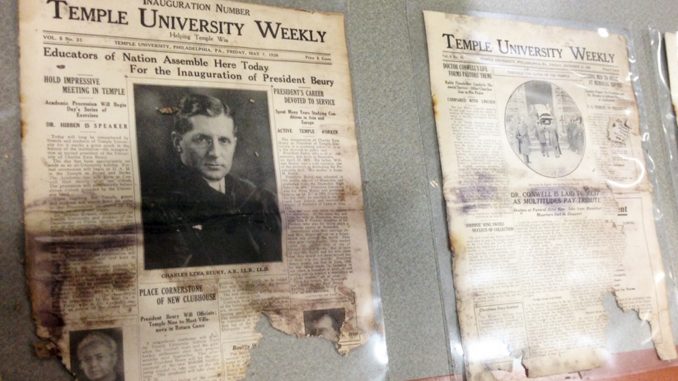
Buried deep in a cornerstone near the historic 1930 building, a large rectangular copper box was packed full of Philadelphia and Temple history artifacts.
Temple Medical School president, faculty and staff at the time left behind newspapers, periodicals and photographs.
Though Temple’s Medical School no longer resides in the building at the corner of Broad and Ontario streets, a piece of its history was preserved in this 84-year-old time capsule discovered at the demolition three weeks ago.
“The time capsule was a lot of paper, but interesting paper,” said Dr. Larry Kaiser, dean of Temple University School of Medicine.
Kaiser had the honor of opening the capsule and presenting it at the demolition site.
“You get a pretty good idea of what was going on at that time in 1930,” Kaiser said. “It was fascinating being able to sort of look back and see what they would have put in there.”
The box held city newspapers, including issues of the Inquirer and Evening Public Ledger from June 1930, as well as Temple University Weekly, the school’s student-run newspaper, from December 1925, the year university founder Russell Conwell died.
There were also photographs, a medical journal, course catalogs, pamphlets and TUSM yearly bulletins dating back to the early 1900s.
Director of the Special Collections Research Center at Paley Library Margery Sly said while most of these materials were already documented in the archives, there was one significant item that was not – a brochure that entailed the dedication ceremony program for the opening of the new medical school building.
“One of the coolest things that I haven’t been able to find a copy of yet was a prospectus about the building,” Sly said. “It was a white brochure that was printed on really good quality paper and had the floor plan of the new building in it. That’s the one item that I’m not sure we have a copy of in the archives already, so we would probably focus our preservation efforts on that.”
Although the box was enclosed in a stone and wedged inside the building’s wall, it was not tightly sealed. Many of the items, like the photographs, suffered water damage.
“I’m sure they thought it was going to be great because they put it in a completely enclosed stone and copper box, but they didn’t seal the box with wax or anything,” Sly said, “They just put a lid on it, and water got in. There were really interesting layers of color in there, depending on what paper had been resting on the tin. The stuff was still moist too, so it’s been decades of water.”
“It was almost like a miniature tomb because it was entirely encased in stone, but not sealed,” she added.
Standing alongside Kaiser in the opening of the capsule, Brad Chilnick, architect and assistant dean of Space Plan & Management, was also present at the demolition site during the discovery.
Chilnick said that though it was “great” to uncover the artificats they did, he was disappointed that there was not a medical, research or teaching artifact.
“There was nothing. I mean come on, give me a stethoscope, give me something that’s physical,” he said. “That’s my world. There was nothing other than paper in there. I would’ve liked to have seen anything that was a medical device they thought was state of the art at that time.”
Interestingly enough, Chilnick said the newspapers were in the best condition of the items.
“That’s another ironic thing,” Chilnick said. “If you have ever tried to save a newspaper and notice how they suck up moisture and crumble – these were in the best condition. You could almost open them, leaf through and read everything.”
Besides the medical school’s pamphlets, catalogs, brochures and photographs, there was not a full historical focus on the original TUSM building.
Chilnick said the newspapers had headlines about sports teams and politicians. “It was almost like their communication was saying, despite all the things going on at this time, we’re putting something new on the earth,” Chilnick said.
The former medical school building demolition is still in process, but Chilnick said the university’s plan is to clear the space and add greenery.
The time capsule’s items were held on display at the Ginsburg Library in the new medical school building at 3500 N. Broad St. until Nov. 10.
The items will be sent to Special Collections Research Center for proper preservation.
Alexa Zizzi Can be reached at alexa.zizzi@temple.edu


Just saw this article about the time capsal. My husband’s great grandfather was an early pioneer of Temple and I was wondering if there is any mention of him in what you found. His name is Dr. Samuel Wolfe. Please let me know if there is anything about him in what was found. Thank you so much.
I have a beautiful photo of Wolfe from 1910
Where can I get a copy of your photo of Wolfe from 1910?J